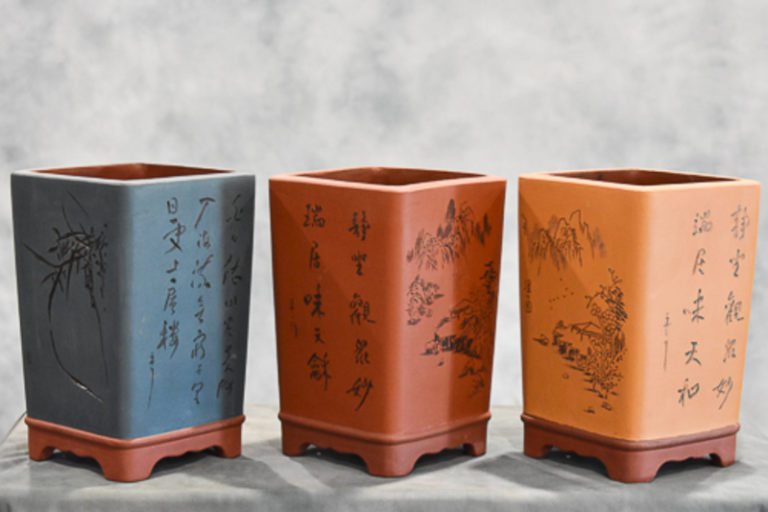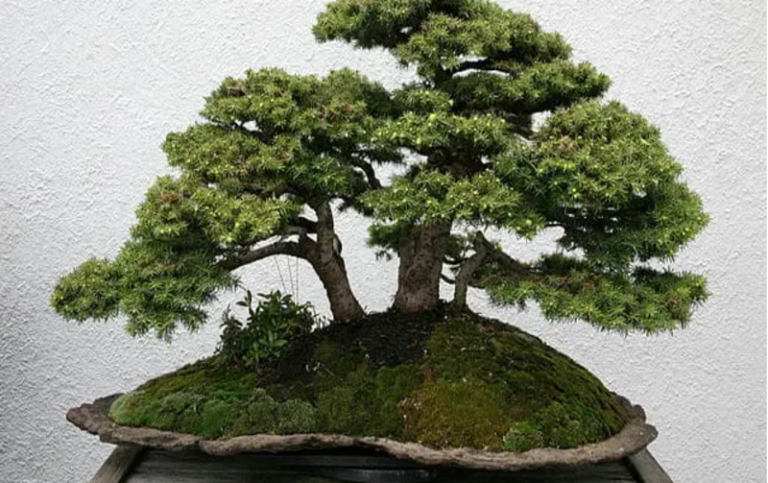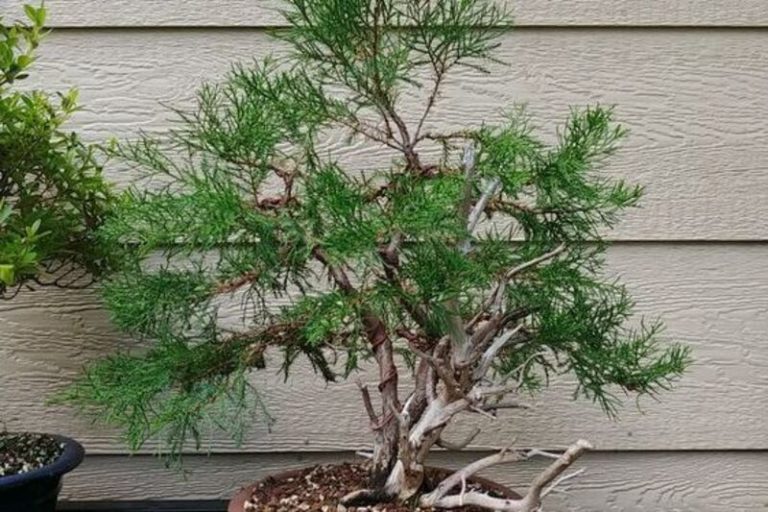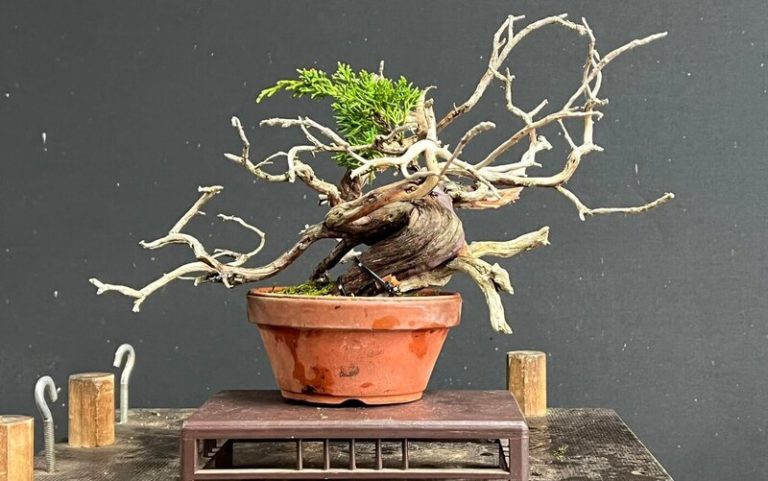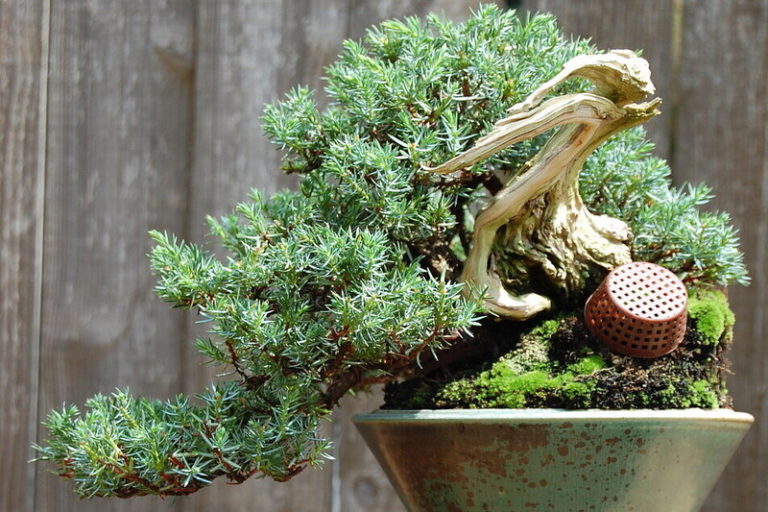Pitch Pine Bonsai : Unveiling the Mystique of Miniature Trees
Pitch pine bonsai is a unique form of miniature tree art that has captured the interest of many gardening enthusiasts. In this article, we will explore what pitch pine bonsai is, its origins, and why it’s important to optimize content for search engines to reach a wider audience.
What is Pitch Pine Bonsai?
The art of pitch pine bonsai is to grow and shape a pitch pine tree (Pinus rigida) into a small shape. It means carefully cutting, shaping, and teaching the tree’s branches to get the look you want. Pitch pine trees are known for their rough look, thick bark, and long needles, which makes them a unique choice for bonsai fans. With the right care and attention, pitch pine bonsai can become beautiful live works of art that bring a sense of natural beauty and calm to any place.
History and Origins of the Pitch Pine Bonsai
The history and origins of pitch pine bonsai can be traced back to the art of bonsai itself, which originated in China over a thousand years ago. Bonsai, meaning “tray planting,” initially focused on creating miniature landscapes with trees, rocks, and other elements.
Later, the art of bonsai made its way to Japan, where it became a big part of Japanese culture and went through a lot of changes and improvements. The methods and looks of bonsai were improved by Japanese artists, making it a highly regarded art form.
Pitch pine bonsai specifically emerged as a result of the appreciation for native tree species in the bonsai community. In Japan, bonsai artists started experimenting with various tree species, including the pitch pine (Pinus rigida), which is native to North America.
The unique characteristics of pitch pine, such as its rugged appearance, thick bark, and long needles, caught the attention of bonsai enthusiasts. They began cultivating and shaping pitch pine trees into miniature forms, incorporating them into the diverse repertoire of bonsai styles.
Over time, the art of pitch pine bonsai gained recognition and popularity both in Japan and around the world. Bonsai enthusiasts embraced the challenge of working with this distinctive tree species and appreciated the unique aesthetic appeal it brought to their collections.
Bonsai artists and fans all over the world continue to practice and respect pitch pine bonsai. The art form shows how far bonsai has come and how it has changed over time. It also shows how beautiful nature is and how creative people can be when they make things.
Pitch Pine Bonsai and Their Symbolism
The history and origins of pitch pine bonsai can be traced back to the art of bonsai itself, which originated in China over a thousand years ago. Bonsai, meaning “tray planting,” initially focused on creating miniature landscapes with trees, rocks, and other elements.
Later, the practice of bonsai moved to Japan, where it became a big part of Japanese culture and went through a lot of changes and improvements. Japanese artists improved the methods and looks of bonsai, making it a highly recognized art form.
Pitch pine bonsai specifically emerged as a result of the appreciation for native tree species in the bonsai community. In Japan, bonsai artists started experimenting with various tree species, including the pitch pine (Pinus rigida), which is native to North America.
The unique characteristics of pitch pine, such as its rugged appearance, thick bark, and long needles, caught the attention of bonsai enthusiasts. They began cultivating and shaping pitch pine trees into miniature forms, incorporating them into the diverse repertoire of bonsai styles.
Over time, the art of pitch pine bonsai gained recognition and popularity both in Japan and around the world. Bonsai enthusiasts embraced the challenge of working with this distinctive tree species and appreciated the unique aesthetic appeal it brought to their collections.
Bonsai artists and fans all over the world continue to practice and respect pitch pine bonsai. The art form shows how far bonsai has come and how it has changed over time. It also shows how beautiful nature is and how creative people can be when they make things.
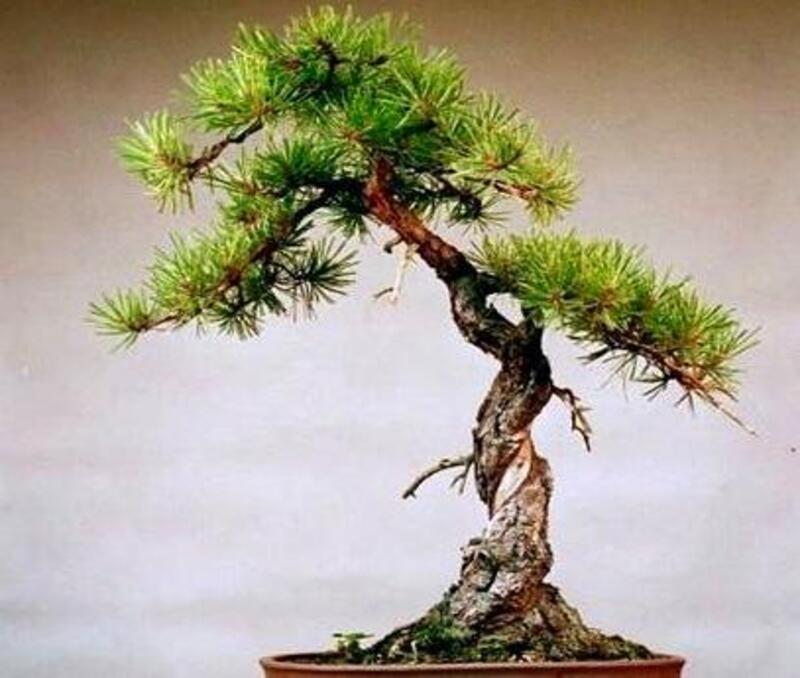
Characteristics of the Pitch Pine Bonsai
The pitch pine bonsai, derived from the pitch pine tree (Pinus rigida), possesses several distinct characteristics that make it a captivating choice for bonsai enthusiasts. These characteristics contribute to its unique appeal and the overall aesthetic of the pitch pine bonsai:
1. Rugged Appearance: The pitch pine bonsai showcases a rugged and weathered appearance, reflecting the tree’s natural habitat in harsh environments. The bark of the pitch pine tree is thick and rough and often displays interesting patterns and textures, adding depth and character to the bonsai.
2. Long Needles: Pitch pine bonsai features long, dark green needles that grow in clusters, creating a distinctive visual element. The length and arrangement of the needles contribute to the overall appearance and texture of the tree.
3. Sturdy Trunk: The trunk of the pitch pine bonsai tends to be sturdy and well-formed. It often exhibits interesting twists, curves, and gnarled features, reminiscent of the tree’s resilience in the face of challenging conditions.
4. Resinous Fragrance: The pitch pine tree produces resin, which gives off a unique and pleasant fragrance. When cared for and pruned, the pitch pine bonsai can release this resinous scent, adding an olfactory dimension to the overall experience of the tree.
5. Tolerant of Harsh Conditions: Pitch pine trees are known for being able to grow well in places with bad soil, rocky ground, and even places where flames are common. This toughness is mirrored in the pitch pine bonsai, making it a great choice for people who like bonsai trees because of their strength.
6. Conical Shape: The pitch pine bonsai typically exhibits a conical or triangular shape, with the branches radiating outwards from the trunk. This natural growth pattern lends itself well to bonsai styling and provides a strong foundation for shaping the tree into various artistic forms.
7. Hardy Nature: Most pitch pine bonsai are hardy and can survive in many different temperatures. It does well both outside and inside, which makes it a good choice for bonsai lovers with different growing conditions.
These characteristics of the pitch pine bonsai contribute to its overall visual appeal and make it an intriguing species to work with in the art of bonsai. Its ruggedness, unique needle structure, and resilience in challenging conditions add depth and interest to any bonsai collection.
How to Grow a Pitch Pine Bonsai
Growing a pitch pine bonsai requires careful attention and adherence to specific cultivation techniques. Follow these steps to cultivate a healthy and thriving pitch pine bonsai:
Selecting a Healthy Specimen:
- Choose a young pitch pine tree with a sturdy trunk, healthy foliage, and well-developed roots.
- Look for a tree that exhibits desirable characteristics, such as interesting bark patterns and a balanced branch structure.
Soil and Pot Selection:
- Use a well-draining bonsai soil mix to ensure proper aeration and moisture retention.
- Select a suitable-sized bonsai pot that provides enough space for root growth while maintaining the desired aesthetics.
Pruning and Wiring:
- Prune the branches to shape and maintain the desired form of the bonsai. Remove any dead, damaged, or overcrowded branches.
- Utilize wiring techniques to guide the growth of branches and achieve the desired overall structure.
Watering and Fertilization:
- Water the pitch pine bonsai thoroughly, allowing the soil to become slightly moist before watering again.
- Fertilize the tree during the growing season (spring to fall) using a balanced bonsai fertilizer. Follow the manufacturer’s instructions for proper dosage and frequency.
Sunlight and Temperature:
- Place the pitch pine bonsai in a location that receives ample sunlight. Pitch pines generally thrive in full sun but can tolerate partial shade.
- Ensure that the bonsai is protected from extreme temperatures, especially during the winter. Provide appropriate insulation or bring it indoors if necessary.
Repotting and Root Maintenance:
- Repot the pitch pine bonsai every two to three years, typically in early spring before new growth begins. This promotes healthy root development and prevents the tree from becoming root-bound.
- During repotting, trim and prune the roots to maintain an appropriate size for the pot. Remove any tangled or excessive roots.
Seasonal Care:
- Adjust the watering frequency and amount based on seasonal changes. Increase watering during hot and dry periods and reduce it during cooler months.
- Protect the bonsai from extreme weather conditions, such as strong winds or frost, by providing shelter or moving it to a more suitable location.
Observation and Maintenance:
- Regularly inspect the pitch pine bonsai for signs of pests, diseases, or nutrient deficiencies. Take appropriate measures, such as using insecticides or adjusting fertilization, to address any issues promptly.
- Prune and shape the bonsai as necessary to maintain its desired form and promote overall health.
By following these guidelines and providing proper care, you can cultivate a thriving pitch pine bonsai that will continue to grow and evolve over time. Remember to be patient, as the art of bonsai is a long-term process that requires dedication and ongoing maintenance.
Benefits of the Pitch Pine Bonsai
Pitch pine bonsai has various advantages for bonsai fans, both in terms of aesthetics and the whole experience of cultivating and caring for this unique tree species. Here are some of the advantages of growing a pitch pine bonsai:
- Visual Appeal: The pitch pine bonsai displays a rugged and distinctive appearance with its thick bark, long needles, and sturdy trunk. Its unique characteristics add an intriguing element to any bonsai collection and make it a visually captivating tree to admire.
- Resilience and Symbolism: The pitch pine tree is known for its resilience and ability to thrive in harsh conditions. By cultivating a pitch pine bonsai, one can appreciate and symbolize the strength, endurance, and adaptability of nature.
- Artistic Expression: Shaping and styling a pitch pine bonsai allows bonsai enthusiasts to express their creativity and artistic vision. The process of pruning, wiring, and forming the tree into desired shapes provides a fulfilling and artistic outlet.
- Learning Opportunity: Growing and caring for a pitch pine bonsai offers valuable learning experiences. It provides insights into the growth habits, horticultural techniques, and natural behavior of the pitch pine species. Bonsai cultivation can enhance one’s knowledge and skills in plant care and horticulture.
- Connection to Nature: On a lesser scale, pitch pine bonsai links people to the beauty of nature. It allows bonsai aficionados to experience and appreciate the grace and intricacy of trees in small form, cultivating a sense of calm, awareness, and a deeper connection with the natural world.
- Therapeutic and Relaxing: Bonsai cultivation, including the care and maintenance of pitch pine bonsai, can be a calming and therapeutic activity. Working with plants has been shown to reduce stress, promote mindfulness, and provide a sense of relaxation and well-being.
- Decorative and Conversation Starter: A well-crafted pitch pine bonsai adds an aesthetic touch to any indoor or outdoor space. Its unique appearance and symbolism make it a captivating conversation starter and a focal point for admiration and contemplation.
- Longevity: Pitch pine bonsai, with proper care and maintenance, can live for many years, even decades. The longevity of a pitch pine bonsai allows for a long-term commitment and a continuous connection with the tree over time.
Overall, pitch pine bonsai is not only an aesthetically stunning addition to any bonsai collection, but it also provides a pleasant and enlightening experience for bonsai aficionados. It blends the creative expression of shape and styling with a greater connection to nature and an appreciation for the pitch pine tree species’ tenacity and beauty.
Displaying and Showcasing the Pitch Pine Bonsai
Displaying and showcasing a pitch pine bonsai is an important aspect of enjoying and sharing its beauty. Here are some tips on how to effectively display and showcase your pitch pine bonsai:
Choose a Suitable Stand or Table: Select a stand or table that complements the aesthetic of your pitch pine bonsai. Consider the size, style, and material of the stand to ensure it enhances the overall presentation.
Placement: Locate a spot that gives adequate illumination for your pitch pine bonsai. Pitch pines flourish in full sun, so a location with plenty of sunshine is preferred. However, keep the bonsai away from harsh weather conditions like high winds, intense heat, or frost.
Consider Background and Surroundings: Create an appealing backdrop for your pitch pine bonsai. A neutral or contrasting background, such as a plain wall or a backdrop of foliage, can help highlight the tree’s unique features. Avoid cluttered or distracting backgrounds that may draw attention away from the bonsai.
Rotation: Periodically rotate your pitch pine bonsai to ensure even exposure to sunlight. This helps promote balanced growth and prevents the tree from leaning or growing in one direction.
Display Techniques: Utilize display techniques such as accent plants, moss, rocks, or small figurines to enhance the overall presentation of your pitch pine bonsai. These elements can complement the style and aesthetic of the bonsai, adding depth and interest to the display.
Showcase Unique Features: Highlight the distinctive characteristics of your pitch pine bonsai. Showcase the textured bark, interesting branch structure, and long needles by positioning the tree in a way that allows viewers to appreciate these unique features.
Bonsai Display Stands and Accessories: Consider using bonsai display stands, turntables, or suiseki (viewing stones) to elevate and enhance the presentation of your pitch pine bonsai. These accessories can add elegance and a sense of harmony to the overall display.
Regular Maintenance: Keep your pitch pine bonsai well-maintained and groomed. Prune and shape the branches regularly to maintain the desired form and remove any dead or overgrown foliage. Clean the bonsai’s trunk, branches, and pot to keep them free from dust and debris.
Showcasing at Bonsai Exhibitions or Events: If you wish to showcase your pitch pine bonsai at bonsai exhibitions or events, carefully prepare it for display. Ensure that the tree is healthy, properly styled, and groomed. Follow any guidelines or requirements provided by the exhibition organizers to present your bonsai in the best possible condition.
Remember, showcasing a pitch pine bonsai is not only about presenting its visual appeal but also about sharing the joy and appreciation for the art of bonsai with others. By effectively displaying and showcasing your pitch pine bonsai, you can inspire and captivate viewers with the beauty and uniqueness of this remarkable tree species.
Styling and Design of a Pitch Pine Bonsai
Styling and designing a pitch pine bonsai involves shaping the tree to create the desired aesthetic and balance. Here are some key considerations and techniques for styling and designing a pitch pine bonsai:
1. Research and Study: Familiarize yourself with the natural growth habits and characteristics of pitch pine trees. Understanding how they grow in the wild will help you create a more natural and realistic design.
2. Determine the Style: Choose a bonsai style that suits your vision and the characteristics of the pitch pine tree. Common styles for pitch pine bonsai include formal upright (Chokkan), informal upright (Moyogi), slanting (Shakan), and windswept (Fukinagashi).
3. Establish the Trunk Line: Identify the main trunk line and consider its movement and taper. The trunk should have an appealing shape and flow, gradually tapering as it ascends.
4. Branch Development: Encourage the development of primary branches that radiate from the trunk in a balanced and visually pleasing manner. Select branches that enhance the overall design and follow the natural growth pattern of the tree.
Pruning and Wiring: Prune the branches selectively to achieve the desired silhouette and balance. Use wiring techniques to guide the growth and placement of branches. Take care not to wire too tightly, as pitch pine branches can be brittle.
5. Create Open Spaces: Aim for an open and airy design by leaving spaces between branches. This helps create depth and allows light to penetrate the interior of the tree, promoting overall health and growth.
6. Consider the Nebari: Nebari refers to the visible surface roots of the bonsai. Encourage the development of surface roots by removing excess soil around the base of the tree. Nebari adds stability and visual appeal to the overall design.
7. Jins and Shari: Jins are deadwood branches, and Shari refers to the deadwood areas on the trunk. Incorporate jins and shari selectively to add age, character, and visual interest to the pitch pine bonsai. Use carving tools to create natural-looking deadwood features.
8. Balance and Proportion: Strive for balance and proportion in the overall design of the bonsai. Consider the relationship between the trunk, branches, foliage mass, and pot size. Ensure that the various elements harmonize and create a pleasing composition.
9. Continual Refinement: Styling and designing a pitch pine bonsai is an ongoing process. Regularly assess and refine the tree’s shape, structure, and overall design over time. Monitor growth, make necessary adjustments, and perform maintenance pruning to maintain the desired aesthetic.
Remember that styling and designing a pitch pine bonsai requires patience and careful observation. Each tree is unique, and the design should reflect its individual characteristics. Embrace the natural beauty and ruggedness of the pitch pine while creating a bonsai that evokes a sense of harmony, balance, and visual appeal.
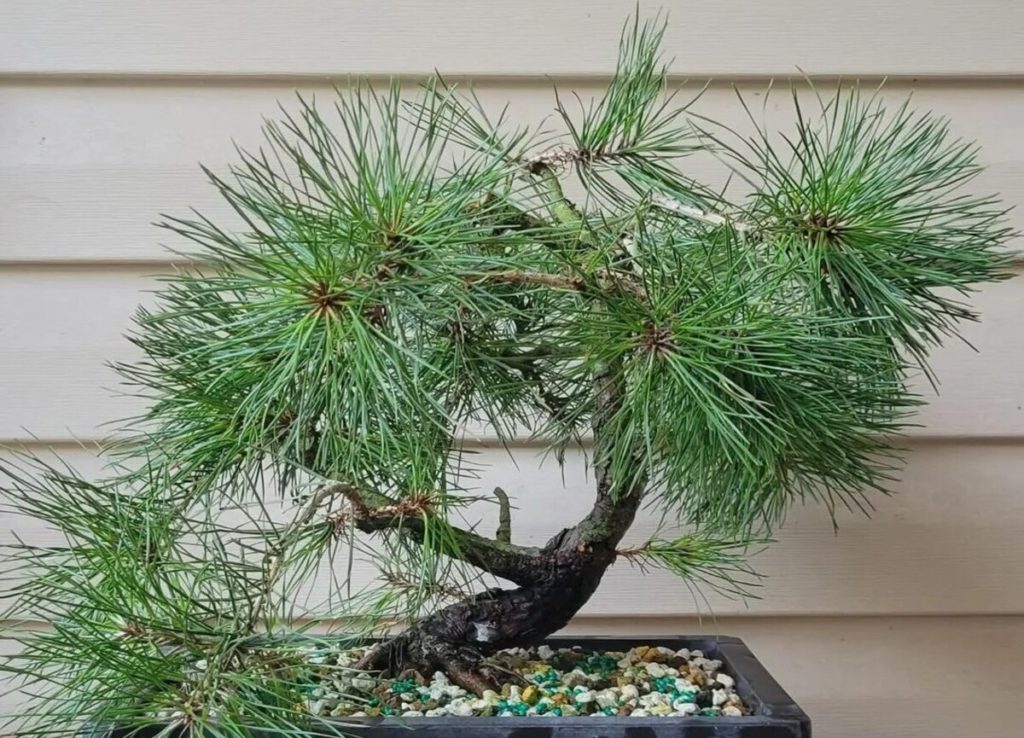
How to Care for and Maintain a Pitch Pine Bonsai
Caring for and maintaining a pitch pine bonsai requires attention to its specific needs to ensure its health and vitality. Here are some essential care tips to keep your pitch pine bonsai thriving:
Watering:
- Monitor the moisture levels in the soil regularly. Water the bonsai when the top layer of the soil feels slightly dry, but avoid letting the soil completely dry out or become waterlogged.
- Water thoroughly until the excess water drains from the drainage holes of the bonsai pot, ensuring that the entire root system receives moisture.
- Adjust the frequency of watering based on environmental factors such as temperature, humidity, and season. Increase watering during hot, dry periods and reduce it during cooler months.
Sunlight and Temperature:
- Place the pitch pine bonsai in a location that receives ample sunlight. Pitch pines generally prefer full sun but can tolerate partial shade.
- Protect the bonsai from extreme temperatures, especially during the winter. Provide insulation or bring the bonsai indoors if the temperature drops below its tolerance level.
Fertilization:
- Apply a balanced bonsai fertilizer during the growing season (spring to fall) to provide essential nutrients. Follow the manufacturer’s instructions regarding dosage and frequency.
- Consider using a slow-release fertilizer to provide a steady supply of nutrients over an extended period.
- Avoid fertilizing during the dormant period in the winter.
Pruning and Wiring:
- Regularly prune the pitch pine bonsai to maintain its shape, remove any dead or damaged branches, and encourage new growth.
- Utilize wiring techniques to guide the growth of branches and achieve the desired aesthetic form. Take care not to wire too tightly, as pitch pine branches can be brittle.
- Prune and thin out the foliage to ensure good airflow and light penetration.
Repotting:
- Repot the pitch pine bonsai every two to three years, usually in early spring before new growth starts.
- Trim and prune the roots during repotting to maintain a compact root system. Remove any tangled or excessive roots.
- Use a well-draining bonsai soil mix to provide proper aeration and moisture retention for the roots.
Pest and Disease Control:
- Regularly inspect the pitch pine bonsai for pests such as aphids, spider mites, or scale insects. Treat any infestations promptly with suitable insecticides or by using organic pest control methods.
- Monitor the tree for signs of diseases like needle blight or root rot. If detected, take appropriate measures to address the issue, such as pruning affected branches or adjusting watering practices.
Winter Care:
- Protect the pitch pine bonsai during the winter by providing adequate insulation. Shield it from freezing temperatures, strong winds, and heavy snowfall.
- Consider placing the bonsai in an unheated but frost-free location, such as an unheated garage or cold frame, to protect it from extreme cold.
Regular Maintenance:
- Remove weeds and moss from the soil surface regularly to maintain cleanliness.
- Clean the trunk, branches, and foliage gently using a soft brush or cloth to remove dust and debris.
- Continually monitor the tree’s health, growth, and appearance, making adjustments as needed to maintain its desired shape and form.
By following these care guidelines and giving your pitch pine bonsai the attention it needs, you can ensure its longevity and enjoy a healthy and beautiful tree for years to come. Remember that each bonsai is unique, so observe your tree closely and adapt your care routine accordingly.
Pitch Pine Bonsai Care Sheet
| Aspect | Care Tips |
| Watering | Monitor soil moisture regularly and water when the top layer feels slightly dry. Avoid overwatering or letting the soil dry out completely. |
| Water thoroughly until excess water drains from the pot’s drainage holes to ensure proper hydration of the root system. | |
| Sunlight | Place the bonsai in a location that receives ample sunlight, preferably full sun. |
| Protect the tree from extreme temperatures and provide shade during hot summer days if necessary. | |
| Temperature | Pitch pines can tolerate a wide range of temperatures, but protect the bonsai from extreme cold or heat. |
| Humidity | Pitch pines can tolerate moderate humidity levels. Avoid exposing the bonsai to excessively dry or humid environments. |
| Fertilization | Apply a balanced bonsai fertilizer during the growing season (spring to fall) according to the manufacturer’s instructions. |
| Consider using a slow-release fertilizer for a steady nutrient supply. | |
| Pruning and Trimming | Regularly prune to maintain shape, remove dead or damaged branches, and encourage new growth. |
| Wiring and Styling | Use wiring techniques to guide branch growth and achieve desired shapes. Avoid wiring too tightly to prevent damage to the branches. |
| Repotting | Repot every two to three years, typically in early spring before new growth starts. |
| Trim and prune the roots to maintain a compact root system. Use a well-draining bonsai soil mix. | |
| Pest and Disease Control | Regularly inspect the bonsai for pests and treat infestations promptly using suitable insecticides or organic pest control methods. |
| Monitor for diseases like needle blight or root rot and take appropriate measures to address them. | |
| Winter Care | Protect the bonsai from freezing temperatures, strong winds, and heavy snowfall. Provide insulation or place it in an unheated but frost-free location. |
| Regular Maintenance | Remove weeds and moss from the soil surface regularly. |
| Clean the trunk, branches, and foliage gently to remove dust and debris. | |
| Continually monitor the tree’s health, growth, and appearance, making adjustments as needed to maintain its shape and form. |
This care sheet table summarizes the key aspects of pitch pine bonsai care and provides concise tips for each aspect. Remember to adapt the care routine based on the specific needs of your bonsai and observe the tree closely to ensure its overall health and well-being.
Conclusion
Pitch pine bonsai is a fascinating art form that offers a creative and rewarding experience. By following the steps outlined in this guide and paying attention to the styling principles, common issues, and display considerations, you can nurture and showcase a beautiful pitch pine bonsai. Enjoy the journey of bonsai cultivation and share your creations with others. Happy bonsai gardening!
FAQ
Q: What is a pitch pine bonsai?
A: Pitch pine bonsai is a miniature version of the pitch pine tree (Pinus rigida) that is cultivated and trained in the art of bonsai. It is characterized by its rugged, twisted bark, long needles, and compact size.
Q: How big do pitch pine bonsai grow?
A: The size of a pitch pine bonsai can vary depending on the age and training of the tree. Generally, pitch pine bonsai can range from 6 inches to 2 feet in height, although larger specimens can also be found.
Q: What are the characteristics of pitch pine bonsai?
A: Pitch pine bonsai is known for its rugged and gnarled appearance. It has dark, textured bark, long, dark green needles, and small, sturdy cones. The branches of pitch pine bonsai often have an irregular growth pattern, giving it a unique and aged look.
Q: Can pitch pine bonsai be kept indoors?
A: While pitch pine bonsai can be temporarily placed indoors for display, it is best suited for outdoor cultivation. Pitch pines require ample sunlight and airflow, which are challenging to provide indoors. It is recommended to keep pitch pine bonsai outdoors to ensure their optimal growth and health.
Q: How often should I water my pitch pine bonsai?
A: The watering frequency for pitch pine bonsai depends on various factors such as climate, pot size, and soil conditions. As a general guideline, water the bonsai when the top layer of soil feels slightly dry. Avoid overwatering or letting the soil completely dry out between watering.
Q: How do I prune pitch pine bonsai?
A: Pruning pitch pine bonsai involves selectively removing branches to maintain its shape and promote new growth. Use sharp bonsai pruning shears to make clean cuts just above a bud or branch junction. Regular pruning helps refine the silhouette and maintain the desired form of the bonsai.
Q: When should I repot my pitch pine bonsai?
A: Repotting pitch pine bonsai is usually done in early spring, before new growth begins, every two to three years. Repotting helps to freshen the soil, prune the roots, and promote healthy growth. However, the frequency may vary based on the tree’s growth pace and general health.
Q: What pests and diseases affect pitch pine bonsai?
A: Common pests that can affect pitch pine bonsai include aphids, spider mites, and scale insects. Diseases such as needle blight or root rot may also occur. Regularly inspect the bonsai for any signs of pests or diseases and take appropriate measures, such as using insecticides or adjusting watering practices, to address the issues.
Q: How can I protect my pitch pine bonsai during winter?
A: During the winter, protect your pitch pine bonsai from cold temperatures, high winds, and heavy snowfall. Place the bonsai in an unheated but frost-free environment, such as an unheated garage or cold frame. Insulate the pot with mulch or horticultural fleece.
Q: Can pitch pine bonsai be trained in different bonsai styles?
A: Yes, pitch pine bonsai can be trained in various styles like formal upright, informal upright, slanting, and windswept.
Q: How long does it take for a pitch pine bonsai to develop?
A: It can take several years or even decades for a pitch pine bonsai to develop into a mature and well-styled tree.
Q: Do pitch pine bonsai require special soil?
A: Pitch pine bonsai require a well-draining bonsai soil mix that provides good aeration and moisture retention.
Q: Can pitch pine bonsai be styled using deadwood techniques?
A: Yes, deadwood techniques like jin and shari can be applied to pitch pine bonsai to add character and age.
Q: How often should I fertilize my pitch pine bonsai?
A: Fertilize pitch pine bonsai every two to four weeks during the growing season using a balanced bonsai fertilizer.
Q: Can pitch pine bonsai be shaped using wiring techniques?
A: Yes, wiring can be used to shape pitch pine bonsai, but care must be taken as their branches can be brittle.
Q: Can pitch pine bonsai be propagated from cuttings or seeds?
A: Pitch pine bonsai can be propagated from cuttings or seeds, but it can be challenging and time-consuming.
Q: How often should I trim the needles of my pitch pine bonsai?
A: Trim the needles of pitch pine bonsai once or twice a year, preferably in late spring or early summer.
Q: Can pitch pine bonsai tolerate air pollution or urban environments?
A: Yes, pitch pine bonsai can tolerate air pollution and urban environments, but they still require clean air and regular care.
Also Read:



